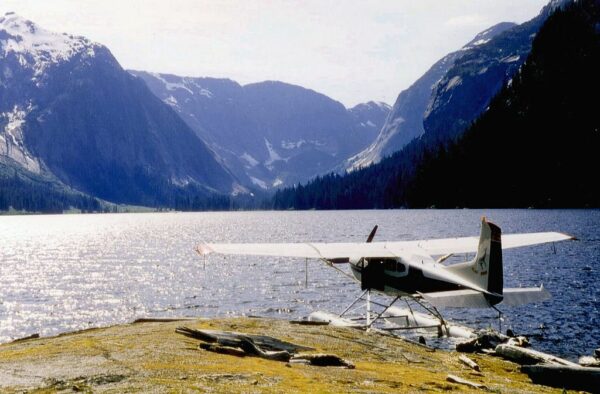
At least 21 people have lost their lives in plane crashes in the Ketchikan area since 2015.
That’s after six — including five out-of-state cruise ship passengers — died in a sightseeing crash in Misty Fjords National Monument on Aug. 5.
The crash has renewed concerns about the number of fatal, small commercial aircraft accidents in Alaska, which, according to an investigation by member station KUCB and ProPublica, is growing relative to the rest of the country.
KUCB and ProPublica reporter Zoë Sobel joined Alaska Public Media’s Casey Grove to talk about the issue.
Listen here:
Casey Grove: A number of these recent fatal crashes have involved sightseeing tours carrying cruise ship passengers. What can you tell me about that?
Zoë Sobel: As you’ve mentioned, since 2015, there have been three fatal accidents that have killed 21 people. And in each of these accidents, some of the people who died were cruise ship passengers. Bill Heuer lost both his sisters and their husbands in 2007 when their sightseeing plane crashed into the mountains near Ketchikan, and they were visiting Alaska on a cruise. Heuer and his family recently marked the 14th anniversary of their family tragedy.
Bill Heuer: A lot of time has gone by. I’m sure people are out there, they probably see some changes. But from the outside it’s same old same.
ZS: Heuer describes the August 5 accident as eerie because it’s around the same time and place as the crash that killed his sisters and their husbands.
RELATED: Fatal crash near Ketchikan renews concerns about safety of Alaska aviation
CG: Do we know why these types of flights have been crashing?
ZS: At this point, it’s way too early to know what caused the August 5 crash. The National Transportation Safety Board is investigating, but it’s unlikely we’ll see their final report for another year or two. The biggest similarities we see in fatal accidents around Ketchikan in recent years is that they were sightseeing flights carrying passengers from cruise ships. These accidents were all in the busy summer months and sometimes there also is poor weather.
CG: So this had already been a major concern of the NTSB, right? What has been done or what’s being done to address these crashes?
ZS: The NTSB has been concerned about small plane commercial aviation in Alaska for a while. Robert Sumwalt is the recently retired chairman of the NTSB, here are his thoughts on the August 5 accident.
Robert Sumwalt: It’s very, very distressing to see yet another sightseeing accident occur — very distressing. I feel that this accident shows that there’s still a lot of work to be done.
[Sign up for Alaska Public Media’s daily newsletter to get our top stories delivered to your inbox.]
ZS: Following a roundtable meeting in 2019, focused on improving small plane aviation, the NTSB issued a safety recommendation asking the Federal Aviation Administration to review and prioritize Alaska’s aviation safety needs and ensure it’s making progress on implementing safety enhancements. The FAA says it’s made the issue a top priority. It’s even launched a new program called the Alaska Aviation Safety Initiative to look at how the agency is providing resources to the state, their effectiveness and what more can be done.
Over the years there also have been safety recommendations from the NTSB, specifically related to sightseeing accidents. Back in 2017, the NTSB asked the FAA to create more conservative rules for the Ketchikan air tour industry. It also asked the FAA to meet with Ketchikan’s air tour operators annually to review operational hazards and collaborate on ways to manage these risks. But the NTSB doesn’t just issue recommendations to the FAA. In 2017, it asked the world’s largest cruise industry trade association to encourage air tour operators that they work with to review the circumstances of a 2015 fatal Ketchikan crash. In that accident the NTSB determined the probable cause was the pilot flew into deteriorating weather and ended up flying into the side of a mountain. But the NTSB also found that the now defunct operator’s company culture endorsed flying into hazardous weather.
CG: Okay, so is the FAA being responsive to these NTSB recommendations though?
ZS: The FAA doesn’t always move forward on NTSB recommendations and, in recent years, the agencies have disagreed more. A review of NTSB data showed that the NTSB found that the FAA didn’t take adequate action on nearly 40% of the recommendations it closed in the past decade. And that’s up from 20% in the 2000s and 15% in the 1990s.
CG: Are pilot qualifications an issue the NTSB is looking into? I mean, how experienced do these pilots have to be before flying passengers in potentially poor weather and rough terrain?
ZS: I’m not aware that pilot qualifications are an issue the NTSB is looking into. That said, Alaska is a place where a lot of new pilots come to get their first commercial experience and build time before moving on to fly for a large air carrier like Delta, United or American Airlines. And pilots for large air carriers typically need to have at least 1,500 hours of flying experience. But pilots for small operators can have as little as 500 hours of experience. They can also fly more hours annually than pilots working for large carriers and are subject to different rest time requirements. We found that some airlines chose to have internal hiring and training standards that are higher than the FAA minimums, but that varies.
CG: Interesting. Do you know if cruise ship passengers are aware of this history when they booked the tours?
ZS: Well, there probably are some people who do a lot of research before booking shoreside excursions. I think there also are those who sign up for a tour when they see it offered. Here’s Bill Heuer. Again, his sisters and their husbands died in a flightseeing accident in 2007in the Misty Fjords.
BH: I think you have a tendency to think or assume that safety is always being taken care of somehow.
ZS: Heuer thinks taking the tour of the Misty Fjords likely was a spur-of-the-moment decision. Over the course of this reporting, one thing that has come up is that it’s very hard for non-aviation people to tell the difference between operators. When a passenger books a ticket for a flight, they expect it to be safe. But what they might not know is that the rules that govern flight operations can vary. There are much stricter rules for larger carriers like United or Alaska Airlines than there are for these o- demand sightseeing tours, and that’s something I didn’t know until I started doing this research.
Casey Grove is host of Alaska News Nightly, a general assignment reporter and an editor at Alaska Public Media. Reach him at cgrove@alaskapublic.org. Read more about Casey here.





